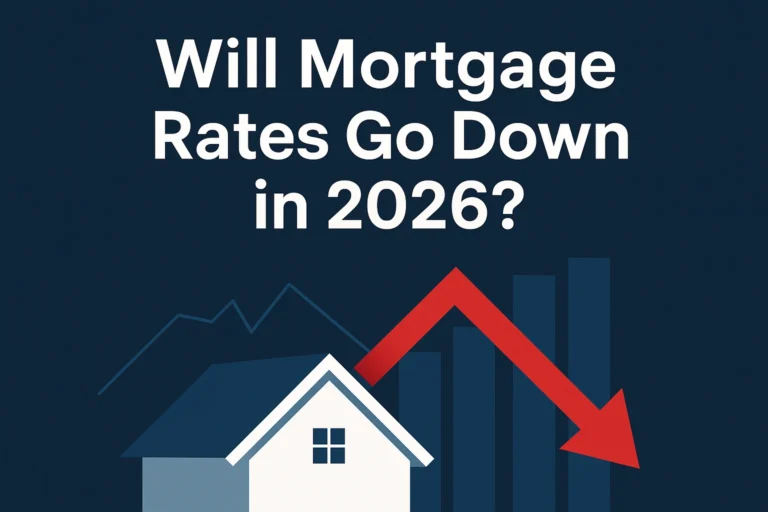Introduction
Mortgage rates in Canada have tugged at Canadians’ nerves for years: homeowners renewing, buyers waiting on the sidelines, and markets adjusting. As 2026 approaches, many ask: “Will mortgage rates go down in 2026 in Canada?” In this article, we explore forecasts, central bank signals, risks, what it means for different mortgage types, and what you as a Canadian borrower can realistically expect.
What Moves Canadian Mortgage Rates
To predict direction, we must first understand what pushes mortgage rates up or down. Here are the key levers in Canada:
- Bank of Canada policy rate (overnight rate).
- The BoC sets its main rate, which filters through to prime rates and variable-rate mortgages.
- In September 2025, the BoC cut its target rate by 25 basis points to 2.50%, its first move in months.
- That signals room for easing, depending on inflation and economic growth.
- Bond yields and mortgage funding costs.
- Lenders borrow in bond markets; if 5-year or 10-year government yields fall, fixed mortgage rates tend to follow.
- Forecasts from economists like TD show government bond yield trends influencing mortgages.
- Inflation & economic conditions.
- If inflation remains sticky or reverses higher, the BoC may hold or raise rates instead of cutting.
- Conversely, slowing demand, weak consumer spending, or global headwinds can push the BoC toward further rate cuts.
- Mortgage competition & lending spreads.
- Banks and lenders add a risk premium (spread) over the base cost. The spread can widen under uncertainty.
- Regulatory stress, credit risks, and housing policy also impact these margins.
- Mortgage renewals & reset cycles.
- Many Canadian mortgages are fixed for 5-year terms. When they expire, borrowers must renew, exposing them to prevailing rates.
- A Bank of Canada staff note predicts 60% of mortgage holders renewing in 2025/2026 will see higher payments, despite rate cuts.
READ MORE: Financial Planning Tips in 2026
Will Rates Fall in 2026?
Here’s a synthesis of various forecasts and what they imply for Canadians:
| Source / Forecast | Outlook | Key Notes |
| WOWA.ca interest rate forecast | Moderately lower variable / fixed rates in 2026 | Predicted 1-year and 2-year fixed rates around ~3.30–3.90% mid-2026. |
| Mortgagesandbox | Fixed rates to rise in 2026 | Projects 5-year fixed to stay above 4%, though variable may drop slightly. |
| Nesto.ca | Gradual rate declines | Suggests possibility of 75 bps drop in 2025, continuing into 2026. |
| British Columbia Real Estate Association (BCREA) | Mortgages expected to fall late 2025 into 2026 | Signals rate easing in fall/early winter. |
| Bank of Canada / staff estimates | Mixed | Many mortgage renewals will see increases even with cuts. |
From these, the picture is mixed but leaning slightly downward, especially for variable rates, while fixed rates may fall only modestly or remain stable.
What “Down” Might Look Like in 2026
Here are possible paths for rates in 2026:
- Modest drop scenario
- Overnight rate: 2.25% → 2.50% range
- Variable mortgage rates: decline 0.25-0.75% from 2025 levels
- Fixed 5-year mortgages: drop 0.25-0.50% if bond yields ease
- Flat / sideways scenario
- BoC holds rates if inflation surprises
- Minor movement upward or downward
- Spreads widen, making mortgage declines muted
- Delayed or reversed drop scenario
- If inflation rebounds or external shocks hit (e.g., global commodity prices, geopolitics)
- Borrowing costs increase again
- Renewing mortgages see sharp increases
READ MORE: Investing Basics for Long-Term Success
What It Means for Canadian Borrowers (Fixed vs Variable)
Variable-rate mortgages
- These are often tied to prime.
- If BoC cuts, variable rate borrowers benefit more immediately.
- This may be the safer bet for those who can absorb some movement.
Fixed-rate mortgages (3-5 year)
- More stable but less responsive to rate cuts.
- If you lock now, you may miss out on small declines.
- But locking in protects you from upward surprises.
Renewals and Payment Shock
- Many will face renewal in 2026. Some forecasts predict average payment increases of 6% over 2024 levels.
- Borrowers should shop aggressively, consider blended or cohorted renewal strategies.
Practical Tips for Prospective Homebuyers and Renewals
- Watch BoC announcements and inflation data, especially CPI, core inflation, and employment.
- Consider variable or short-term fixed if you believe rate cuts will come.
- Shop lenders negotiate spreads and ask for discounting.
- Use amortization strategies shorter amortization reduces interest burden.
- Build buffer assume your rate might not drop, or could increase unexpectedly.
- Lock portions if possible split mortgage renewals across terms.
- Monitor bond markets 5-year bond yields often foreshadow fixed rate movement.
READ MORE: Top Budgeting Apps in 2026
Bottom Line and Outlook for 2026
Will mortgage rates go down in Canada in 2026? Yes, but not dramatically more likely modest to moderate declines, especially for variable rates. Fixed rates may inch down, but will remain influenced by bond yields and lender margins.
If Canada’s inflation continues cooling, economic growth weakens, and global risks stay contained, BoC may cautiously ease. But uncertainty remains high rate cuts may be gradual and limited.
For borrowers: being flexible, shopping the market, and understanding your mortgage term matters more than chasing tiny rate movements.

